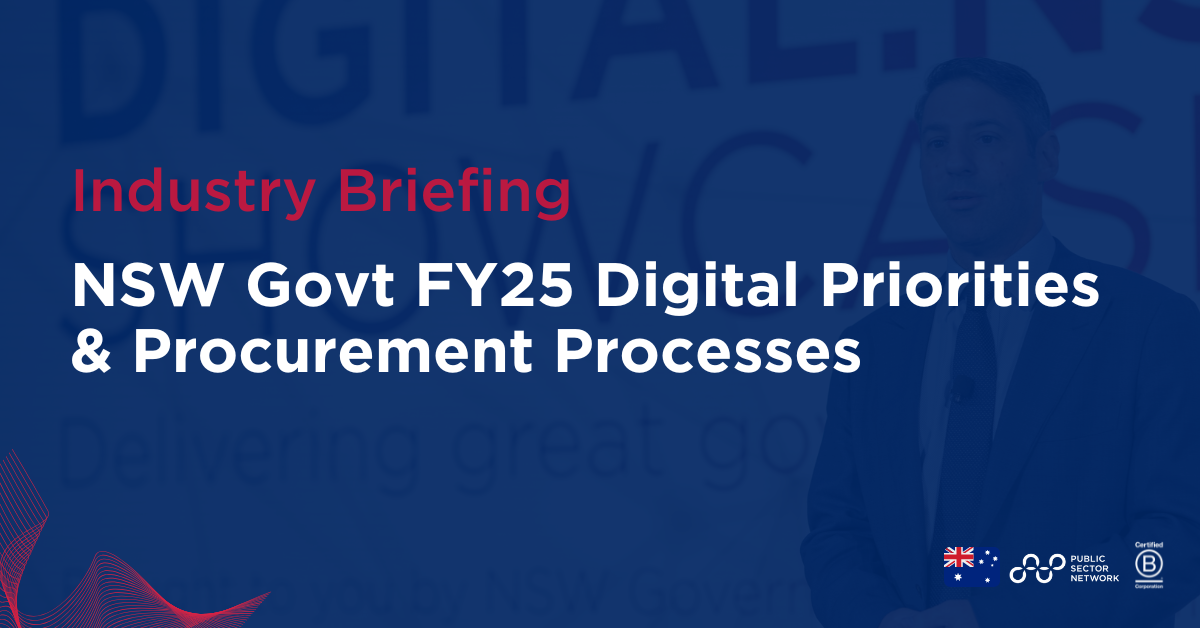

The government of New South Wales (NSW) has been steadily advancing its digital transformation, aligning with the broader public sector’s aim to enhance service delivery, improve efficiency, and foster innovation. For the 2025 financial year, NSW is focusing on key strategies to streamline digital initiatives and optimize procurement processes.
On the 21st of August, Public Sector Network spoke with Mark Lenzner, the Executive Director ICT / Digital Sourcing for NSW Department of Customer Service in a live webinar about the major priorities and procurement pathways that will impact the NSW IT Sales climate in the coming year.
The following provides a strategic summary and key takeaways of this session and covers three core areas: major digitization strategies, updates to the ICT Digital Sourcing function, and procurement paths to help businesses engage with the NSW Government.
Read on the learn about:
- Major digitization strategies
- ICT Digital Sourcing Function Updates
- Procurement paths and resources to help you engage with the NSW Government
Major 2025 Digitization Strategies
NSW's digitization strategies for the 2025 financial year build upon the priorities set in the 2024-25 state budget, described as a “budget of must-haves.” These priorities encompass essential government services such as housing, roads, public transport, and health. The digitization efforts support these services and extend to new initiatives like cybersecurity, digital licensing, and the development of a new NSW digital identity.
In the short term, digitization will focus heavily on enabling key government priorities while optimizing current investments to contribute to budget repair and efficiency dividends. This means suppliers and service providers will be expected to demonstrate how their offerings can extract maximum value from the government’s existing digital infrastructure.
Looking ahead, future investments will align with the upcoming State Digital Strategy, a critical framework that will guide ICT spending and digital initiatives. This strategy focuses on five key missions:
- Accessibility and inclusiveness for all citizens of NSW.
- Leveraging digital services to enhance service delivery and improve productivity.
- Building trust through reliable, stable government services and infrastructure.
- Ensuring the safety and resilience of NSW through better disaster response capabilities.
- Uplifting the digital capabilities of the NSW public sector workforce
Additionally, NSW is addressing the issue of legacy systems, which pose a significant challenge to the progress of digital initiatives. The NSW State of Legacy Report, which is currently still being written, outlines areas where the government’s technological debt is highest, and where modernization efforts are needed. Addressing legacy systems will be a central theme in future ICT investments, driving the government’s focus on both cost-effective modernization and sustainable digital infrastructure.
ICT Digital Sourcing Function Updates
NSW’s ICT procurement landscape is undergoing significant reform as it embraces modern, agile procurement methods. Led by Mark Lensner, Executive Director of ICT and Digital Sourcing for the NSW Department of Customer Service, the department is implementing changes to make procurement more efficient, transparent, and accessible.
The Buy NSW platform continues to be the cornerstone of these efforts, centralizing sourcing activities and providing a unified platform for procurement. This platform simplifies procurement by pre-qualifying suppliers, streamlining contract management, and offering a centralized view of all government procurement activities. Pre-negotiated government contracts further enable departments to benefit from the collective buying power of the NSW Government, ensuring that procurement is cost-effective and timely.
In a major update, the NSW Procurement Board recently issued a new direction requiring all procurements exceeding AUD 150,000to be published on the Buy NSW Tenders module. This mandate covers both open and selective procurements, improving transparency and making it easier for suppliers to track opportunities. The directive also introduces new functionalities in the Buy NSW Opportunities Hub which matches supplier capabilities to specific government needs using an advanced taxonomy system.
To ensure suppliers can engage effectively with this evolving procurement environment, the NSW Government is emphasizing the importance of staying up to date with frameworks such as the AI Assessment Frameworkand AI Ethics Policy which provide guidelines for responsibly procuring and deploying artificial intelligence solutions. With AI becoming a significant focus, understanding these frameworks is crucial for suppliers looking to offer AI-driven solutions to the government.
Procurement Paths and Resources to Help You Engage with the NSW Government
Navigating the NSW Government’s procurement processes can be complex, especially for smaller businesses. However, there are several key resources and paths suppliers can use to engage with the government and secure opportunities.
The Buy NSW platform is the central hub for procurement, offering a seamless experience for suppliers of all sizes. The platform’s Opportunities Hub and Tenders module provide visibility into both open and selective procurement opportunities, ensuring that suppliers can engage with the government throughout the procurement lifecycle
For businesses new to working with the NSW Government, registering on the Buy NSW platform and joining the ICT Services Scheme is a critical first step. This allows businesses to be matched with relevant opportunities, ensuring they can showcase their capabilities to government buyers.
Small and medium enterprises (SMEs) can also take advantage of the NSW Small Business Charter, which simplifies procurement processes, reduces administrative burdens, and increases tender weightings for local content, job creation, and ethical supply chains.
Furthermore, industry events such as the Digital NSW Showcase, scheduled for November 2025, provide invaluable networking opportunities. These events allow suppliers to engage directly with government decision-makers, understand upcoming priorities, and position their offerings to meet government needs.
Suppliers interested in contributing to the government’s digital transformation efforts should also stay informed on new initiatives through the Digital NSW website and social media channels. Key resources, including the upcoming State Digital Strategy and policy updates, will be published here, ensuring suppliers have access to the most up-to-date information.
Lastly, for those in industries related to cybersecurity, the NSW Government is expected to establish new purchasing arrangements in the coming months. These procurement arrangements will support the government’s growing focus on cybersecurity solutions to protect critical infrastructure and data.
Conclusion
The NSW Government’s priorities for the 2025 financial year are firmly rooted in advancing digital transformation while maintaining fiscal responsibility. For suppliers, this presents both challenges and opportunities, particularly in aligning with the government’s focus on budget repair, legacy system modernization, and ethical procurement practices. By leveraging platforms like Buy NSW, understanding the updated procurement frameworks, and staying informed on upcoming initiatives, suppliers can successfully engage with the NSW Government and contribute to the state’s digital future.

































